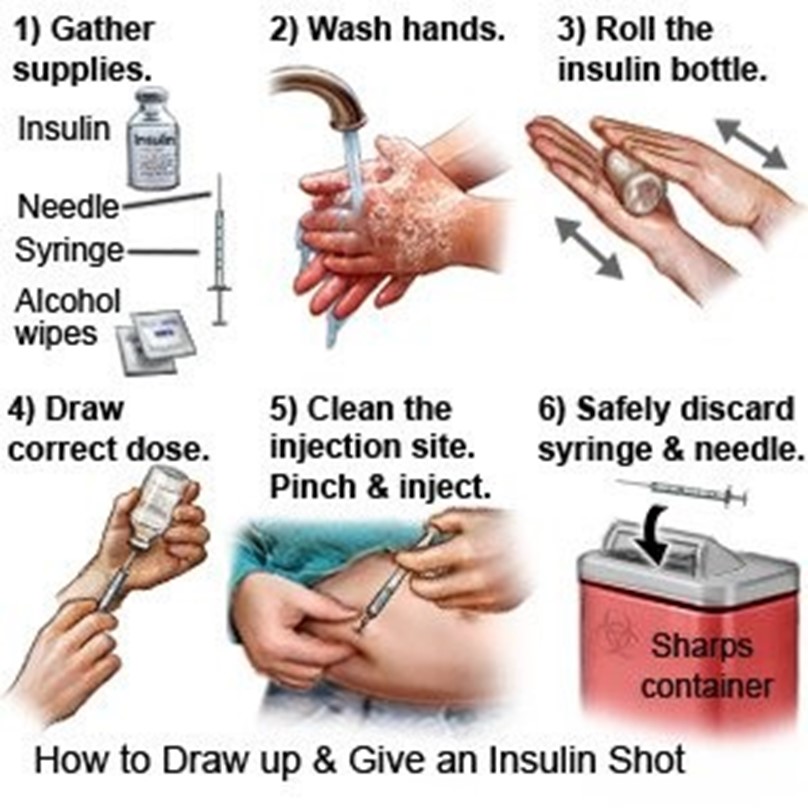A nurse is providing teaching about self-administration of insulin to the parent of a school-age child who has a new diagnosis of diabetes mellitus. Which of the following statements by the parent indicates a need for further teaching?
"The insulin can be injected anywhere there is adipose tissue."
"I will be sure my child rotates sites after 5 injections in one area."
"I will be sure my child aspirates before injecting the insulin."
"The insulin should be injected at a 90-degree angle."
The Correct Answer is C
Choice A: This statement does not indicate a need for further teaching, as it is correct that insulin can be injected anywhere there is adipose tissue. Adipose tissue is the layer of fat under the skin that can absorb insulin and prevent damage to muscles or organs. The common sites for insulin injection are the abdomen, thighs, buttocks, or upper arms.
Choice B: This statement does not indicate a need for further teaching, as it is correct that the child should rotate sites after 5 injections in one area. Rotating sites can prevent lipodystrophy, which is a condition that causes abnormal changes in fat tissue due to repeated injections. Lipodystrophy can affect the appearance and absorption of insulin in the affected area.
Choice C: This statement indicates a need for further teaching, as it is incorrect that the child should aspirate before injecting the insulin. Aspiration is the process of pulling back on the plunger of the syringe to check for blood before injecting the medication. Aspiration is not recommended for insulin injection, as it can cause pain, bruising, or leakage of insulin from the injection site.
Choice D: This statement does not indicate a need for further teaching, as it is correct that insulin should be injected at a 90-degree angle. Injecting insulin at a 90-degree angle can ensure that the medication reaches the adipose tissue and prevents skin irritation or muscle damage. The only exception is if the child has very thin skin or uses very short needles, in which case they may inject at a 45-degree angle.

Nursing Test Bank
Naxlex Comprehensive Predictor Exams
Related Questions
Correct Answer is ["A","C","E"]
Explanation
Choice A: Allowing the child to keep a toy from home with her can help reduce her fear and anxiety by providing comfort, distraction, and familiarity. This strategy can also enhance the child's sense of control and autonomy by letting her choose what toy to bring.
Choice B: Using mummy restraints during painful procedures can increase the child's fear and anxiety by making her feel trapped, helpless, and powerless. This strategy can also damage the child's trust and cooperation with the nurse and cause psychological trauma.
Choice C: Having a parent stay with the child during procedures can help reduce her fear and anxiety by providing support, reassurance, and security. This strategy can also enhance the child's coping skills and resilience by modeling calm and positive behaviors.
Choice D: Planning invasive procedures whenever possible can increase the child's fear and anxiety by exposing her to unnecessary pain and discomfort. This strategy can also impair the child's physical and emotional development by causing stress and inflammation.
Choice E: Performing the procedure as quickly as possible can help reduce her fear and anxiety by minimizing the duration and intensity of pain. This strategy can also enhance the child's satisfaction and compliance by showing respect and empathy.
Correct Answer is C
Explanation
The correct answer is: c. Hold the infant’s chin to his chest and knees to his abdomen during the procedure.
Choice A: Apply a eutectic mixture of lidocaine and prilocaine cream topically 15 min prior to the procedure.
Applying a eutectic mixture of lidocaine and prilocaine (EMLA) cream can help reduce pain during procedures like lumbar punctures. However, it typically needs to be applied 30 to 60 minutes before the procedure to be effective. Applying it only 15 minutes prior would not provide adequate analgesia.
Choice B: Keep the infant NPO for 6 hr prior to the procedure.
Keeping an infant NPO (nothing by mouth) for 6 hours is generally recommended before procedures requiring sedation or anesthesia to reduce the risk of aspiration. However, lumbar punctures do not typically require such prolonged fasting, especially in infants, unless sedation is planned.
Choice C: Hold the infant’s chin to his chest and knees to his abdomen during the procedure.
This is the correct positioning for a lumbar puncture in infants. The infant should be held in a curled-up position, with the chin to the chest and knees to the abdomen, to maximize the space between the vertebrae and allow easier access to the lumbar region. This position helps to stabilize the infant and reduce movement during the procedure.
Choice D: Place the infant in an infant seat for 2 hr following the procedure.
Post-procedure care for a lumbar puncture typically involves monitoring the infant for any signs of complications, such as headache or infection. Placing the infant in an infant seat for 2 hours is not a standard recommendation. Instead, the infant should be observed and allowed to rest comfortably.
Whether you are a student looking to ace your exams or a practicing nurse seeking to enhance your expertise , our nursing education contents will empower you with the confidence and competence to make a difference in the lives of patients and become a respected leader in the healthcare field.
Visit Naxlex, invest in your future and unlock endless possibilities with our unparalleled nursing education contents today
Report Wrong Answer on the Current Question
Do you disagree with the answer? If yes, what is your expected answer? Explain.
Kindly be descriptive with the issue you are facing.
